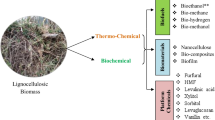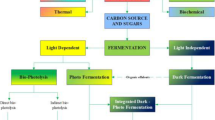Abstract
Biorefinery applications require microbial cell factories for the conversion of various sugars derived from lignocellulosic material into value-added chemicals. Here, the capabilities of the yeast Candida lignohabitans to utilize a range of such sugars is characterized. Substrates efficiently converted by this yeast include the pentoses xylose and arabinose. Genetic engineering of C. lignohabitans with the isolated endogenous GAP promoter and GAP terminator was successful. GFP expression was used as a proof of functionality for the isolated transcription elements. Expression of lactate dehydrogenase and cis-aconitate decarboxylase resulted in stable and reproducible production of lactic acid and itaconic acid, respectively. The desired organic acids were accumulated converting pure sugars as well as lignocellulosic hydrolysates. C. lignohabitans proved therefore to be a promising reliable microbial host for production of organic acids from lignocellulosic material.






Similar content being viewed by others
References
Basso LR, Bartiss A, Mao Y et al (2010) Transformation of Candida albicans with a synthetic hygromycin B resistance gene. Yeast 27:1039–1048. doi:10.1002/yea.1813
Bettiga M, Bengtsson O, Hahn-Hägerdal B, Gorwa-Grauslund MF (2009) Arabinose and xylose fermentation by recombinant Saccharomyces cerevisiae expressing a fungal pentose utilization pathway. Microb Cell Fact 8:40. doi:10.1186/1475-2859-8-40
Bettiga M, Hahn-Hägerdal B, Gorwa-Grauslund MF (2008) Comparing the xylose reductase/xylitol dehydrogenase and xylose isomerase pathways in arabinose and xylose fermenting Saccharomyces cerevisiae strains. Biotechnol Biofuels 1:16. doi:10.1186/1754-6834-1-16
Blumhoff M, Steiger MG, Marx H et al (2013) Six novel constitutive promoters for metabolic engineering of Aspergillus niger. Appl Microbiol Biotechnol 97:259–267. doi:10.1007/s00253-012-4207-9
Branduardi P, Sauer M, De Gioia L et al (2006) Lactate production yield from engineered yeasts is dependent from the host background, the lactate dehydrogenase source and the lactate export. Microb Cell Fact 5:4. doi:10.1186/1475-2859-5-4
Brodeur G, Yau E, Badal K et al (2011) Chemical and physicochemical pretreatment of lignocellulosic biomass: a review. Enzyme Res 2011:787532. doi:10.4061/2011/787532
Delic M, Mattanovich D, Gasser B (2010) Monitoring intracellular redox conditions in the endoplasmic reticulum of living yeasts. FEMS Microbiol Lett 306:61–66. doi:10.1111/j.1574-6968.2010.01935.x
Fernandes S, Murray P (2010) Metabolic engineering for improved microbial pentose fermentation. Bioeng Bugs 1:424–428. doi:10.4161/bbug.1.6.12724
Hahn-Hägerdal B, Karhumaa K, Fonseca C et al (2007) Towards industrial pentose-fermenting yeast strains. Appl Microbiol Biotechnol 74:937–953. doi:10.1007/s00253-006-0827-2
Hara A, Ueda M, Misawa S et al (2000) A mutated hygromycin resistance gene is functional in the n-alkane-assimilating yeast Candida tropicalis. Arch Microbiol 173:187–192
Heer D, Sauer U (2008) Identification of furfural as a key toxin in lignocellulosic hydrolysates and evolution of a tolerant yeast strain. Microb Biotechnol 1:497–506. doi:10.1111/j.1751-7915.2008.00050.x
Ilmén M, Koivuranta K, Ruohonen L et al (2007) Efficient production of l-lactic acid from xylose by Pichia stipitis. Appl Environ Microbiol 73:117–123. doi:10.1128/AEM.01311-06
Kawaguchi Y, Honda H, Taniguchi-Morimura J, Iwasaki S (1989) The codon CUG is read as serine in an asporogenic yeast Candida cylindracea. Nature 341:164–166. doi:10.1038/341164a0
Klement T, Büchs J (2013) Itaconic acid—a biotechnological process in change. Bioresour Technol 135:422–431. doi:10.1016/j.biortech.2012.11.141
Kurtzman CP (2007) Eleven new species of Sugiyamaella and Candida from forest habitats. FEMS Yeast Res 7:1046–1063. doi:10.1111/j.1567-1364.2007.00224.x
Kurtzman CP, Fell JW, Boekhout T (2011) The Yeasts, a taxonomic study, 5th edn. Elsevier Science B.V, Amsterdam
Limtong S, Sumpradit T, Kitpreechavanich V et al (2000) Effect of acetic acid on growth and ethanol fermentation of xylose fermenting yeast and Saccharomyces cerevisiae. Kasetsart J Nat Sci 34:64–73
Liu ZL, Slininger PJ, Dien BS et al (2004) Adaptive response of yeasts to furfural and 5-hydroxymethylfurfural and new chemical evidence for HMF conversion to 2,5-bis-hydroxymethylfuran. J Ind Microbiol Biotechnol 31:345–352. doi:10.1007/s10295-004-0148-3
Modig T, Lidén G, Taherzadeh MJ (2002) Inhibition effects of furfural on alcohol dehydrogenase, aldehyde dehydrogenase and pyruvate dehydrogenase. Biochem J 363:769–776
Noda F, Hayashi K, Mizunuma T (1982) Influence of pH on inhibitory activity of acetic acid on osmophilic yeasts used in brine fermentation of soy sauce. Appl Environ Microbiol 43:245–246
Okabe M, Lies D, Kanamasa S, Park EY (2009) Biotechnological production of itaconic acid and its biosynthesis in Aspergillus terreus. Appl Microbiol Biotechnol 84:597–606. doi:10.1007/s00253-009-2132-3
Pesole G, Lotti M, Alberghina L, Saccone C (1995) Evolutionary origin of nonuniversal CUGSer codon in some Candida species as inferred from a molecular phylogeny. Genetics 141:903–907
Porro D, Bianchi MM, Brambilla L et al (1999) Replacement of a metabolic pathway for large-scale production of lactic acid from engineered yeasts. Appl Environ Microbiol 65:4211–4215
Porro D, Brambilla L, Ranzi BM et al (1995) Development of metabolically engineered Saccharomyces cerevisiae cells for the production of lactic acid. Biotechnol Prog 11:294–298. doi:10.1021/bp00033a009
Sambrook J, Russell D (2001) Molecular cloning: a laboratory manual, 3rd edn. Cold Spring Harbor Laboratory, Cold Spring Harbor, NY
Santos MA, Tuite MF (1995) The CUG codon is decoded in vivo as serine and not leucine in Candida albicans. Nucleic Acids Res 23:1481–1486
Sasano Y, Watanabe D, Ukibe K et al (2012) Overexpression of the yeast transcription activator Msn2 confers furfural resistance and increases the initial fermentation rate in ethanol production. J Biosci Bioeng 113:451–455. doi:10.1016/j.jbiosc.2011.11.017
Sauer M, Porro D, Mattanovich D, Branduardi P (2010) 16 years research on lactic acid production with yeast—ready for the market? Biotechnol Genet Eng Rev 27:229–256
Sousa MJ et al (2012) Cell metabolism—cell homeostasis and stress response. Intech. doi:10.5772/1081
Stadlmayr G, Mecklenbräuker A, Rothmüller M et al (2010) Identification and characterisation of novel Pichia pastoris promoters for heterologous protein production. J Biotechnol 150:519–529. doi:10.1016/j.jbiotec.2010.09.957
Toivola A, Yarrow D, van den Bosch E et al (1984) Alcoholic fermentation of d-xylose by yeasts. Appl Environ Microbiol 47:1221–1223
Urbina H, Frank R, Blackwell M (2013) Scheffersomyces cryptocercus: a new xylose-fermenting yeast associated with the gut of wood roaches and new combinations in the Sugiyamaella yeast clade. Mycologia 105:650–660. doi:10.3852/12-094
Werner S, Engler C, Weber E et al (2012) Fast track assembly of multigene constructs using golden gate cloning and the MoClo system. Bioeng Bugs 3:38–43. doi:10.4161/bbug.3.1.18223
Yehuda H, Droby S, Wisniewski M, Goldway M (2001) A transformation system for the biocontrol yeast, Candida oleophila, based on hygromycin B resistance. Curr Genet 40:282–287
Zhao XQ, Bai FW (2009) Mechanisms of yeast stress tolerance and its manipulation for efficient fuel ethanol production. J Biotechnol 144:23–30. doi:10.1016/j.jbiotec.2009.05.001
Acknowledgments
The authors thank Verena Puxbaum for the help with the fluorescent microscopy pictures, Basso LR et al. for providing plasmids with C. albicans hygromycin B resistance gene, Rupert Koeberl (TDZ Ennstal, Reichraming, Austria) for the supply of pretreated lignocellulosic material and Novozymes (Bagsvaerd, Denmark) for samples of Cellic CTec2®. Finally, we thank the University of Natural Resources and Life Sciences Vienna—VIBT Imaging Center for access and expertise with the Leica DMI 6000 fluorescence microscope. This project was financed by the Austrian Research Promotion Agency (FFG), program “Intelligente Produktion” (FFG project n° 834297).
Conflict of interest
The authors declare no conflict of interest.
Author information
Authors and Affiliations
Corresponding author
Rights and permissions
About this article
Cite this article
Bellasio, M., Mattanovich, D., Sauer, M. et al. Organic acids from lignocellulose: Candida lignohabitans as a new microbial cell factory. J Ind Microbiol Biotechnol 42, 681–691 (2015). https://doi.org/10.1007/s10295-015-1590-0
Received:
Accepted:
Published:
Issue Date:
DOI: https://doi.org/10.1007/s10295-015-1590-0




